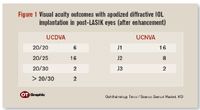Article
Success possible with diffractive lens in patients who underwent prior LASIK
Use of an apodized diffractive IOL in patients needing cataract surgery after prior refractive surgery is considered to be contraindicated, but excellent outcomes can be achieved if optical results are near emmetropia. Success depends on control of surgically induced astigmatism, use of accurate formulae, careful patient selection, and enhancement as necessary.

Key Points

"We can be very successful with these lenses in patients who have undergone prior LASIK correction, but the success depends, obviously, on control of surgically induced astigmatism, using accurate formulae, careful patient selection, and enhancement as necessary," said Dr. Masket, of Advanced Vision Care, Los Angeles and clinical professor, University of California, Los Angeles.
His comment stems from results of a study he conducted. His coauthor was Shaleen Belani, MD. "The question I sought to answer: Is it a good idea to put the [diffractive] lens in patients with prior LASIK, knowing that these patients have very high expectations from the outcome of surgery?" Dr. Masket said. "On one side, when we look at the FDA trials, one of the strong indications [for patient selection] is, in fact, patients who no longer desire to wear glasses. Well, that matches post-LASIK patients. But on the exclusion side, patients who had previous refractive surgery were excluded from the FDA trials, and that would, therefore, be a contraindication."
In addition, the IOL power formulae must be accurate in the post-LASIK eye, Dr. Masket said, noting that his published regression formula has been "very accurate in use" (Masket S, Masket SE. Simple regression formula for intraocular lens power adjustment in eyes requiring cataract surgery after excimer laser photoablation. J Cataract Refract Surg. 2006;32:430-434). The formula: IOL adjustment = LSE × (–0.326) + 0.101, wherein LSE is the spherical equivalent of the amount of laser vision correction.
An advantage
On the other hand, he said, an "advantage that you have in patients after LASIK is that many of them could have their flaps lifted if there was adequate tissue for you to make an enhancement for them."

Presurgical biometry was performed using partial coherence interferometry, and appropriate formulae were applied for IOL power calculation. Dr. Masket's nomogram was used to adjust final IOL power according to the amount of prior laser treatment.
Phacoemulsification was performed through clear corneal temporal incisions using topical and intracameral anesthesia. Outcomes measures were uncorrected distance visual acuity (UCDVA), uncorrected near visual acuity (UCNVA), refractive outcome, spectacle independence, and patient satisfaction.
Dr. Masket noted that the diffractive lens can be implanted via a 2.2-mm incision instead of a larger incision, thereby helping to reduce the incidence of surgically induced astigmatism.
Newsletter
Don’t miss out—get Ophthalmology Times updates on the latest clinical advancements and expert interviews, straight to your inbox.




